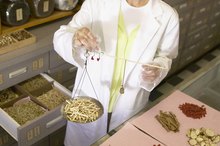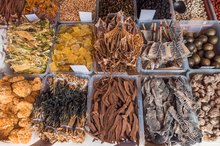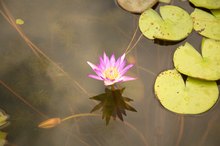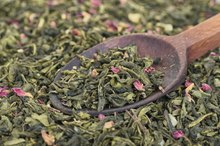What does fact checked mean?
At Healthfully, we strive to deliver objective content that is accurate and up-to-date. Our team periodically reviews articles in order to ensure content quality. The sources cited below consist of evidence from peer-reviewed journals, prominent medical organizations, academic associations, and government data.
- Molecules: Chemical Composition and Biological Properties of Rhododendron Anthopogon Essential Oil
- Molecules: Chemical Composition and Biological Properties of Rhododendron Anthopogon Essential Oil
- Organic Letters: Highly Acylated Diterpenoids with a New 3,4-secograyanane Skeleton from the Flower Buds of Rhododendron Molle
- Organic Letters: Highly Acylated Diterpenoids with a New 3,4-secograyanane Skeleton from the Flower Buds of Rhododendron Molle
- Phytotherapy Research: Effect of Taxifolin Glycoside on Atopic Dermatitis-like Skin Lesions in NC/Nga Mice
- Phytotherapy Research: Effect of Taxifolin Glycoside on Atopic Dermatitis-like Skin Lesions in NC/Nga Mice
- Molecular Pain: A Role of Periaqueductal Grey NR2B-containing NMDA Receptor in Mediating Persistent Inflammatory Pain
- Molecular Pain: A Role of Periaqueductal Grey NR2B-containing NMDA Receptor in Mediating Persistent Inflammatory Pain
The information contained on this site is for informational purposes only, and should not be used as a substitute for the advice of a professional health care provider. Please check with the appropriate physician regarding health questions and concerns. Although we strive to deliver accurate and up-to-date information, no guarantee to that effect is made.
Benefits of the Rhododendron Herb
Rhododendrons are evergreens that belong to the same family as azaleas, with 800 species that grow around the world from Nepal to West Virginia. Parts of certain rhododendron species are toxic to both humans and animals; people have become ill just from eating honey made by bees feeding on the flowers. However, scientists are finding that extracts from other rhododendrons have properties that show promise in treating diseases.
If you are experiencing serious medical symptoms, seek emergency treatment immediately.
Antimicrobial
Italian researchers at the University of Padova studied the composition of an essential oil from the Rhododendron anthopogon species 1. They were able to isolate compounds that showed a significant killing effect against strains of bacteria like Staphylococcus aureus, Enterococcus faecalis, Bacillus subtilis and Mycobacterium tuberculosis and fungi like Candida. These antimicrobial effects were found with doses as low as 0.04 percent solution.
Cancer
Herbs That Stimulate the Pituitary Gland
Learn More
The same Italian study that discovered antimicrobial properties in rhododendron also determined that the essential oil reduced cancer cell growth independently of either the cell line or the treatment protocols used. Additional research published in the April 2010 issues of “Organic Letters” reported that a compound isolated from the flower buds of the Rhododendron molle species showed selective cytotoxic activity against a human hepatoma carcinoma cell line 2.
Dermatitis
Patients with atopic dermatitis, a type of skin disorder similar to eczema, often have increased levels of eosinophils and pro-inflammatory factors. Researchers at China’s Chung-Ang University College of Medicine used extracts from the roots of Rhododendron mucronulatum that were either applied topically or injected into laboratory animals that had an atopic dermatitis condition. The mice exhibited measurable reduced levels of eosinophils and other inflammatory markers after treatment with the extract.
Inflammatory Pain
Lion's Mane Mushroom for Nerve Damage
Learn More
In December 2009, the journal “Molecular Pain” published a study that looked at efforts to mediate persistent inflammatory pain. The experiment used Hyperoside, one of the flavonoids isolated from Rhododendron ponticum L., which significantly reversed the effects of NMDA pain receptors in the spinal cord and exhibited analgesic activities against persistent inflammatory stimuli in mice.
Kidney and Liver Function
A study at China’s Tongji Medical College found that rhododendron root extracts were able to regulate kidney function. Two follow-up studies in India wanted to see whether extracts from Rhododendron arboreum had a similar positive role in the liver. An ethanol-based extract from the leaves was given to rats with induced liver damage in varying doses for five days, with results showing a definitely hepatoprotective property, possibly because of its reported antioxidant activity from the quercetin related flavonoids present in the plant.
Related Articles
References
- Molecules: Chemical Composition and Biological Properties of Rhododendron Anthopogon Essential Oil
- Organic Letters: Highly Acylated Diterpenoids with a New 3,4-secograyanane Skeleton from the Flower Buds of Rhododendron Molle
- Phytotherapy Research: Effect of Taxifolin Glycoside on Atopic Dermatitis-like Skin Lesions in NC/Nga Mice
- Molecular Pain: A Role of Periaqueductal Grey NR2B-containing NMDA Receptor in Mediating Persistent Inflammatory Pain
Writer Bio
Bonnie Singleton has been writing professionally since 1996. She has written for various newspapers and magazines including "The Washington Times" and "Woman's World." She also wrote for the BBC-TV news magazine "From Washington" and worked for Discovery Channel online for more than a decade. Singleton holds a master's degree in musicology from Florida State University and is a member of the American Independent Writers.









